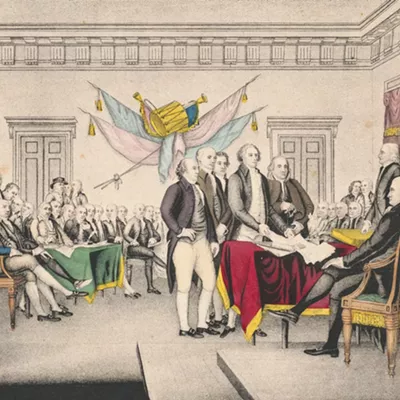Bush's failure to consider this most basic of consequences should come as no surprise. The utter ineptitude of his administration has been compounded by what Lawrence Freedman observes in his review of George Packer's book, The Assassin's Gate, to be "its cavalier assumption that Iraq could be transformed without any extraordinary U.S. efforts."
We now understand that in Bush's mind, this invasion was always about nailing Saddam Hussein -- and never about "nation building," which, after all, Bush and Cheney opposed during the 2000 presidential campaign. The dead giveaway was the president's demand that the congressional resolution authorizing military force include a reference to Saddam's alleged plot to, in Bush's words, "kill my Dad." And speaking of the vice president, can there be any doubt left that Cheney performs the role of an asexual Rasputin to Bush's inept Czar Nicholas?
Anyway, others are asking the questions that Lehrer left hanging, and a debate has been joined. On the one side are analysts and military experts who can be identified as "casualty-phobes." On the other are those identified as "defeat-phobes."
Citing public opinion polls from the Korean, Vietnam and Iraq wars, Ohio State University political scientist John Mueller sees a negative correlation between casualties and public support. In all three wars, he argues, public support declined over time in proportion to the number of battle deaths.
Christopher Gelpi, a Duke University political scientist, argues that Mueller misreads the data. The public supports wars, says Gelpi, when it believes America is winning even if battle fatalities are high.
Gelpi argues, for example, that up until the 1968 Tet Offensive, more than half the public continued to support the war despite more than 20,000 fatalities. Because of how Tet was portrayed by the American media, Gelpi says public opinion swung against the war; not because of fatalities but because the public was led to believe that America could not win.
Mueller, in his rebuttal, points out that his analysis reveals a trend, which was downward before, during and after Tet, with the single constant being that of fatalities.
Both scholars, however, ignore factors that make such one-dimensional comparisons between Vietnam and Iraq (let alone Korea) problematic. For example, the public's support for war, any war, is influenced also by the public's confidence in the president and his administration. Confidence may or may not have anything to do with death counts nor even with immediate perceptions of winning or losing.
The importance of public confidence in any administration cannot be overstated because administrations direct public perception through their own communication. Here's how it works: & lt;ul & & lt;li & Wars result from attacks, or the threat of attack; & lt;li & Threat perception, even the characterization of an attack, is the work of government; & lt;li & It falls to governmental leadership to explain attacks and threats and rally the public to a response; & lt;li & Confidence in the messenger, the leader, inspires the creation of reality. Even in politics, therefore, we realize that life imitates art. & lt;/ul &
We recall Winston Churchill's famous line uttered after the British victory at El Alamein: "This is not the end. It is not even the beginning of the end. But it may, perhaps, be the end of the beginning." We note that this battle was won in 1942. The war would go on for three more years. Many had died, and many more would die. And there would be more defeats. But because the public believed in Churchill, he continued to enjoy the public's confidence, which meant the public would continue to rally to his call.
The charitable observer would say of the Bush administration that it marketed a marginally credible threat to justify taking out Saddam Hussein. Given that the threat no longer is persuasive, and given that this is a kind of conflict where progress -- winning or losing -- will always be most difficult to measure, it's a good bet that, barring some change in circumstances, Mueller's thesis will prove valid and that fatalities will drive public opinion.
But suppose, as many respected observers argue, regardless of how we got where we are, that neither the best interests of the United States nor of Iraq are served if fatalities, taken alone, determine the future of American involvement? What then? By ignoring the correlation between casualties and public support, the president is backing the country into a corner from which there are no satisfactory escape routes.
Which brings us back to the questions about acceptable fatalities that Lehrer didn't ask. Bush needs to answer these questions and make his case. He may not be thinking about a casualty limit, but the rest of America is. Win or lose, if in Bush's mind we are at "the end of the beginning," he needs to say so. He needs to make his case. Otherwise, the country wallows in a morass of disingenuousness deeper than the mess he made by invading Iraq so cavalierly.















